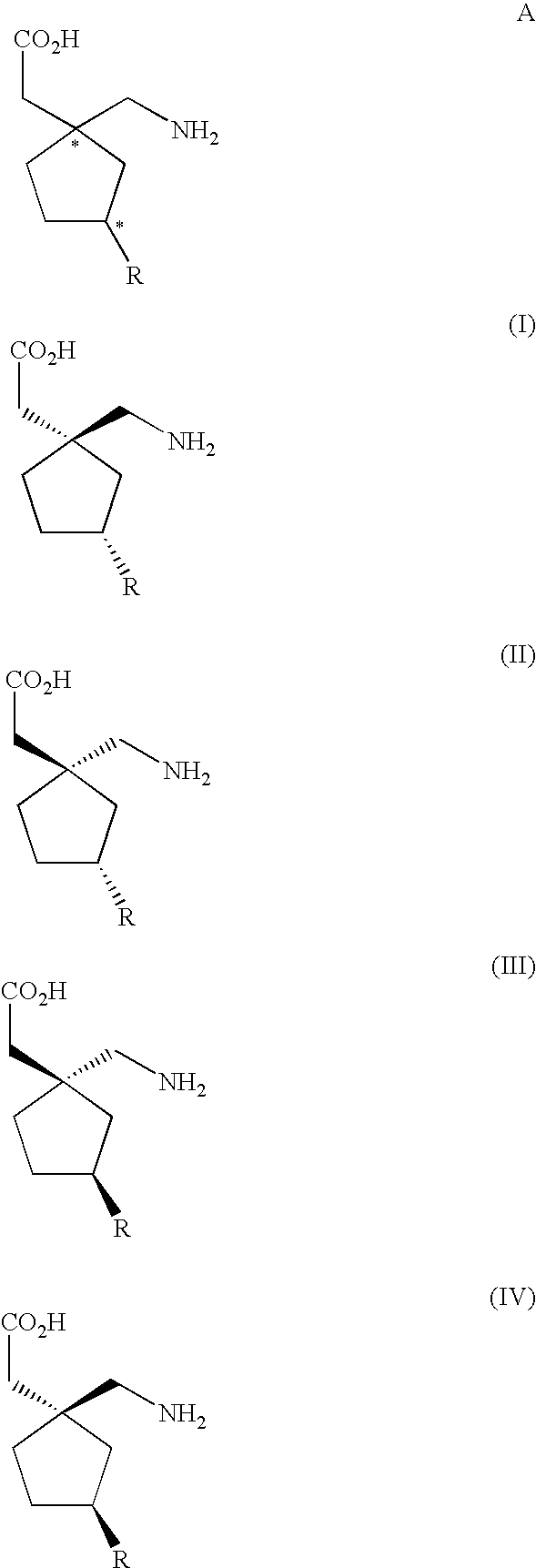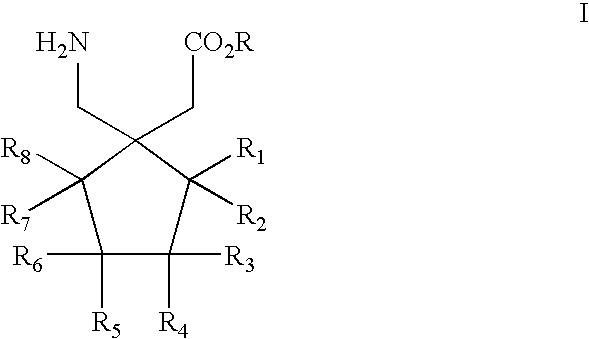Novel method for the stereoselective synthesis of cyclic amino acids
- Summary
- Abstract
- Description
- Claims
- Application Information
AI Technical Summary
Benefits of technology
Problems solved by technology
Method used
Image
Examples
example 1
[0449]
(E and Z)-Cyano-((R)-3-methyl-cyclopentylidene)-acetic acid ethyl ester
[0450] (R)-(+)-3-Methylcyclopentanone (5 g, 51.0 mmol), ethyl cyanoacetate (5.42 mL, 51.0 mmol), ammonium acetate (0.4 g, 5.1 mmol), and glacial acetic acid (0.58 mL. 10.2 mmol) were refluxed in toluene (30 mL) using a Dean-Stark trap. After 6 hours, the mixture was allowed to cool and diluted with ethyl acetate (100 mL), washed with water (3×80 mL), brine, and dried (MgSO4). The solvent was evaporated under reduced pressure. The residue was chromatographed (silica gel, heptane / ethyl acetate, 9:1) to give 8.87 g (90%) of a 1:1 mixture of (E and Z)-cyano-((R)-3-methyl-cyclopentylidene)-acetic acid ethyl ester;
[0451] Rf (heptane-ethyl acetate, 9:1) 0.28:
[0452] IR thin film (cm−1) 2225 (CN), 1724 (C═O), 1617 (C═C);
[0453]1H-NMR (400 MHz; CDCl3): δ 4.27 (2H, q, J 7.2. CO2CH2Me), 4.26 (2H q, J 7.2. CO2CH2Me), 3.35 (1H, dt, J 7.1. 1.6), 3.30 (1H, dt, J 7.1. 1.6), 3.23 (1H, ddd, J 8.1. 3.5, 1.7), 3.18 (1H, ddd,...
example 2
[0484]
((1S,3R)-1-Benzyl-3-methyl-cyclopentyl)-acetic acid methyl ester
[0485] Trimethylsilyldiazomethane (31.5 mL of a 2 M solution in hexanes, 63 mmol) was added dropwise to a stirring solution of ((1S,3R)-1-benzyl-3-methyl-cyclopentyl)-acetic acid (10 g, 43 mmol) in toluene (80 mL) and methanol (20 mL) at 0° C. under argon, and the mixture was allowed to warm to room temperature. The mixture was stirred for 1 hour, and then the solvent was evaporated under reduced pressure. The residue was taken up in ethyl acetate (50 mL), washed with saturated sodium hydrogen carbonate solution, dilute hydrochloric acid, dried (MgSO4), and the solvent removed in vacuo to give 10.6 g (100%) of ((1S,3R)-1-benzyl-3-methyl-cyclopentyl)-acetic acid methyl ester
[0486] Rf (heptane-ethyl acetate, 9:1) 0.40.
[0487] IR thin film (cm−1) 1736 (C═O);
[0488]1H-NMR (400 MHz, CDCl3): δ 7.30-7.18 (5H, m, Ph), 3.69 (3H, s, OMe), 2.78 (1H, d, J 13.4, CHAHBCO2Me), 2.72 (1H, d, J 13.4, CHAHBCO2Me), 2.28 (2H, s, CH2...
example 3
[0503]
((1S,3R)-1-Benzyl-3-methyl-cyclopentyl)-acetic acid tert-butyl ester
[0504] Oxalyl chloride (4.14 mL, 47 mmol) was added dropwise to a stirring solution of ((1S,3R)-1-benzyl-3-methyl-cyclopentyl)-acetic acid (10 g, 43 mmol) in dichloromethane under argon at room temperature. The reaction mixture was cooled to 5° C., dimethylformamide (1 mL) was carefully added, and the mixture was allowed to warm to room temperature and stirred for a further 2 hours. The solvent was removed in vacuo and the residue diluted with dichloromethane (60 mL), 1,1-Dimethylethanol (15 mL) was carefully added to the reaction mixture under arson followed by diisopropylethylamine (11.5 mL, 65 mmol). The mixture was stirred for 17 hours and then taken up in ethyl acetate, washed with saturated aqueous sodium hydrogen carbonate (2×200 mL), and dried (MgSO4). The solvent was removed under reduced pressure, and the residue was purified by chromatography (silica gel, eluting with a gradient of heptane to 9:1 h...
PUM
| Property | Measurement | Unit |
|---|---|---|
| Temperature | aaaaa | aaaaa |
| Temperature | aaaaa | aaaaa |
| Electrical conductance | aaaaa | aaaaa |
Abstract
Description
Claims
Application Information
 Login to View More
Login to View More - R&D
- Intellectual Property
- Life Sciences
- Materials
- Tech Scout
- Unparalleled Data Quality
- Higher Quality Content
- 60% Fewer Hallucinations
Browse by: Latest US Patents, China's latest patents, Technical Efficacy Thesaurus, Application Domain, Technology Topic, Popular Technical Reports.
© 2025 PatSnap. All rights reserved.Legal|Privacy policy|Modern Slavery Act Transparency Statement|Sitemap|About US| Contact US: help@patsnap.com



